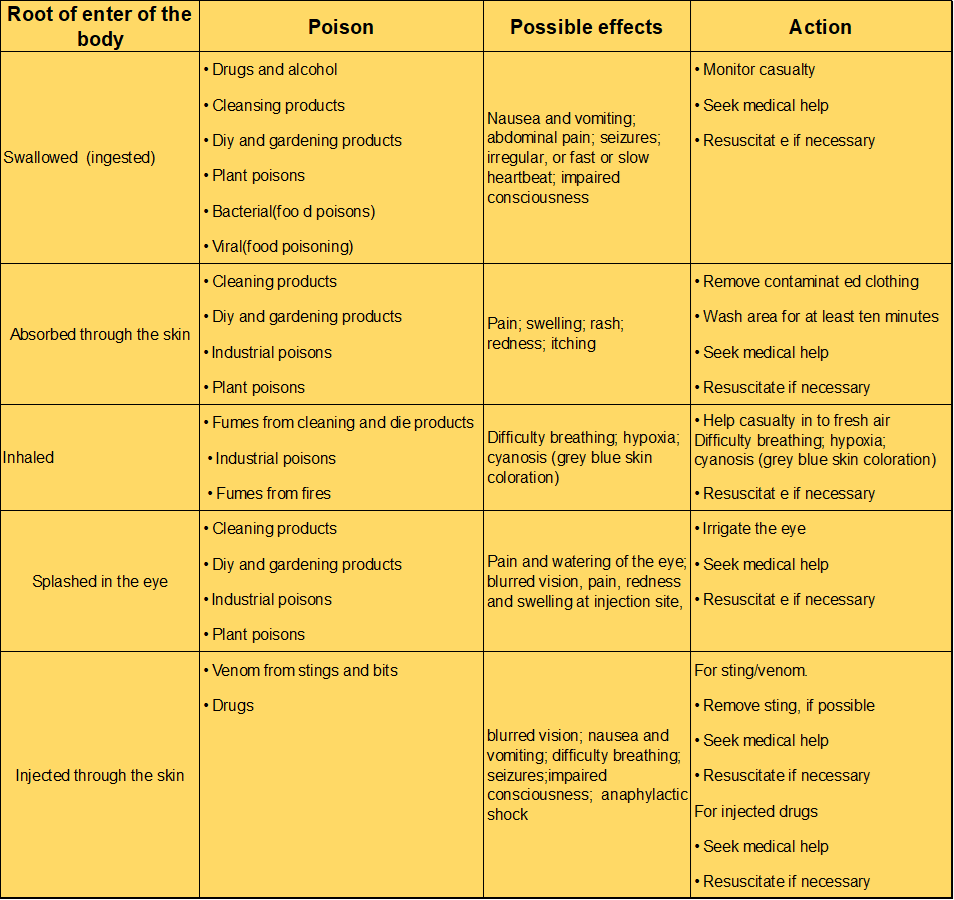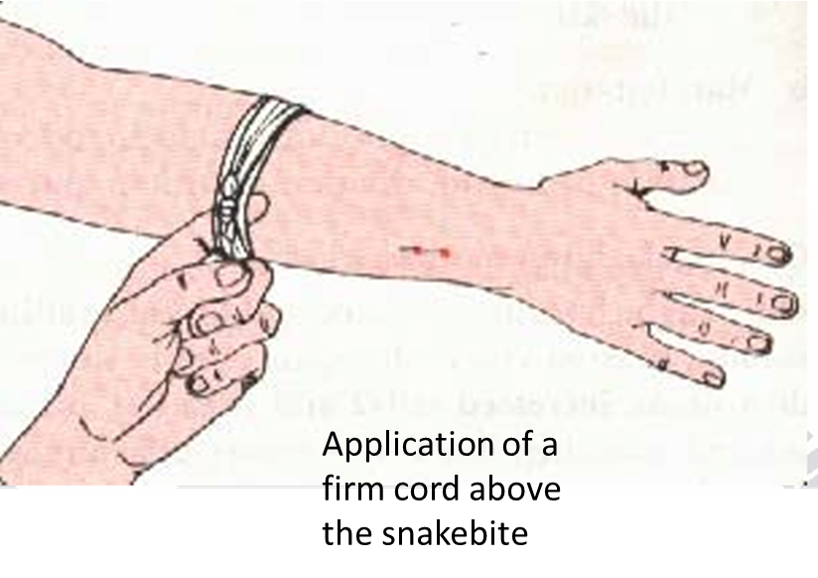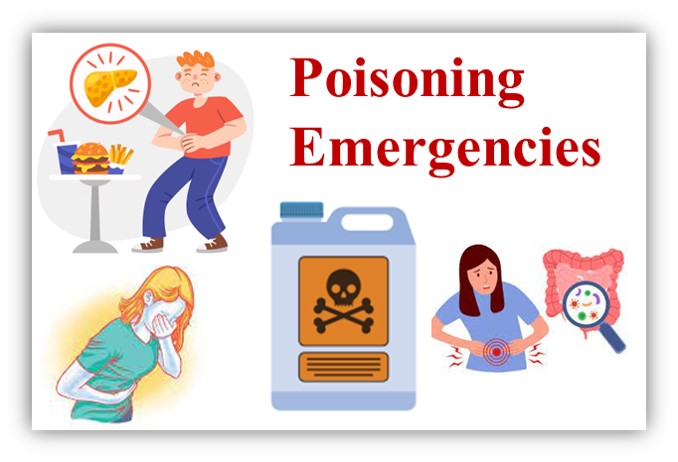A poison is any substance solid, liquid or gas that tends to impair health or cause death when introduced in to the body or on to the skin surface.
Small children are especially likely to become poisoned since they tend to put in their mouths nearly everything that they pick up. However, adults are subject to poisoning also.
Types of poisoning
Some poisons are man-made, such as chemicals and drugs- and this are found in the home as well as in industry. Almost every household contains substances that are potentially poisonous, such as bleach and paint stripper, as well as prescribed or over-the counter medicines, which may be dangerous if taken in excessive amounts. Other poisons occur in nature fore example, plants produce poisons that may irritate the skin or cause more serious symptoms if ingested, and various insects and creatures produce venom in their bites and stings. Contamination of food by bacteria may result in food poisoning-one of the most common forms of poisoning.

Frequent causes of poisoning
- Aspirin overdose especially in children.
- Poisons transferred from original containers to other containers or soft drink bottles.
- Carelessness of the parents in leaving dangerous substance and medicines within reach of children (lack of supervision of children).
- Improper storage and disposal of poisonous substances.
- Improper handling of spray equipment including the mixing of pesticides, insecticides and weed killers.
- Inhalation or swallowing of poisonous substance.
- Carelessness in taking a poison from the medicine cabinet.
- Overdoses of drugs taken either accidentally or with suicidal intent
- Combining some drugs and alcohol
Examples of poisons around the home
Poisonous substances with in the home environment are extremely prevalent and it would be difficult to name all of them. A few typical household poisons are listed below:
- Cosmetics and hair preparations
- Gasoline, kerosene and other petroleum products.
- Paint and turpentine
- Strong detergents
- Bleaches
- Cleaning solutions
- Acids
- Ammonia
- Glue
- Poisonous plants
- Non edible mushrooms
- DDT
- Dry cell
- Malathine etc.
Ways in which poisoning may occur
- Through the mouth (by ingestion)
- Through the skin (by absorption)
- Through the lung (by inhalation)
- By injection
Signs and Symptoms of Poisoning
Symptoms of poisoning vary greatly. Aids in determining whether or not a victim has swallowed poison include:
- Information from the victim or from an observer.
- Presence of a container known to contain poison.
- Conditions of the victim (sudden onset of pain or illness).
- Burns around the lips or mouth.
- Breathe odor.
- Pupils of the eyes contracted to pinpoint size from an overdose of morphine or similar drugs.
Objectives in treatment of poisoning by mouth
The objectives in treatment of poisoning by mouth are:
- To dilute the poisons quickly as possible.
- To seek medical advice from a physician or a poison control center.
- To maintain respiration or circulation.
- To preserve vital functions and to seek medical assistance with out delay.
First aid measures for poisons swallowed through mouth for a conscious victim
- Give him a drink of tepid water with soap in it.
- Repeat the procedure of inducing vomiting until the vomiting is clear.
- Do not induce vomiting if the poison is one which burns or if it is petrol or kerosene. Instead, give milk with egg whites or a mixture of flour and water.
- Safe the label or container of the suspected poison for identification. If the victim vomits safe a sample of the vomited material for analysis.
For unconscious victim
- Maintain an open airway and administer artificial respiration.
- Don’t give fluids and don’t induce vomiting.
- If the victim is vomiting, position him and turn the head so that the vomitus drains out of the mouth.
- Safe the label or container of the suspected poison for identification. If the victim vomits safe a sample of the vomited material for analysis.
First aid for victim having convulsion
- Do not attempt to restrain the victim but position him in a way that he should not injure him self
- Loosen tight clothes at the victims neck and west
- Watch for an obstruction of air way and attempt to correct by head positioning, if necessary give artificial respiration.
- Do not give any fluid
- Do not induce vomiting
Contact poisoning
Contact with Poisonous Chemicals
Harsh chemicals and corrosive poisons if spilled on the skin produce chemical burns which require immediate first aid action.
First Aid for Contact Poisons chemicals
- Remove the contaminated clothing immediately, drench and flush the affected skin with large amounts of water or special neutralizing agents if they are available as you remove the clothes.
- If poisoning is from a pesticide, a corrosive substance (strong acid or alkali), send for ambulance immediately.
- Continue washing all contaminated skin with soap and water for at least 5 minutes.
- Keep the victims air way open, give artificial respiration if indicated
- Do not leave the victim alone.
Contact with Poisonous Plants
The majority of skin reactions following contact with offending plants is allergic in nature and is characterized by:
- General symptoms of headache and fever
- Itching
- Redness
- Rash
First Aid Measures for Poisonous Plants
- Remove contaminated clothing.
- Wash all exposed areas thoroughly with soap and water followed by running alcohol.
- Apply calamine or other soothing skin lotion if the rash is mild.
- Seek medical advice if a severe reaction occurs or if there is a known history of previous sensitivity.
Poisoning Through Inhalation (Gas Poisoning)
Carbon monoxide poisoning is the most poisonous gas formed from incomplete burning of fuel, particularly treacherous because it is completely odorless.
First Aid Measures
- Move the patient in to fresh air to help get rid of the gas in his lungs.
- Give mouth-to-mouth respiration and cardiac massage if necessary. Take care that his breath does not contaminate your breathing, by turning your mouth away from the victim’s mouth between breathes.
Poisoning Through Injection (Snake Bites)
Three are different kinds of poisonous snakes in different parts of the world. All reaction from poisonous snake bites is aggravated by acute fear and anxiety.
Factors affecting the out come of poisonous snake bites
- The amount of venom injected in the speed of absorption of the venom in to the victim circulation.
- The size of the victim
- Protection from clothing, including shoes and gloves
- Location of the bite
- Specific anti venom therapy as soon as possible
Signs and symptoms of major snake bites
- Extremely painful
- Rapid swelling
- One or more puncture wounds created by the fangs
- General discoloration of the skin
Objectives of first aid
- To reduce the circulation of blood through the bite area
- To delay absorption of venom.
- To prevent aggravation of the local wound and to sustain respiration.
First Aid Measures
The most important step is to get a snake bite victim to hospital quickly. Meanwhile take the following first aid measures.
- Keep the victim from moving around
- Calm the victim
- Immobilize the bitten extremity and keep it at or below the heart level.
- Apply a firm but not tight cord just above the bite. This must be removed within 15 minutes or when you have the medical assistance.
- Wipe the wound of venom which may have spilled from the fangs at the time of biting.


